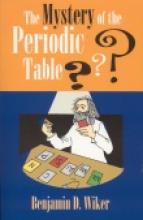Chemistry
Christian Kids Explore Chemistry
The Mystery of the Periodic Table
This new title from Bethlehem Books follows the tradition of Jeanne Bendick with her books on Archimedes and Galen by making scientific concepts accessible to ordinary people.
Dr. Wiker is a prolific author of articles on matters relating to science and the faith. He has taught at Thomas Aquinas College and Franciscan University of Steubenville.
Wiker takes us all the way back to the Neolithic era to begin his story of mankind's fascination with metals that started the development of the science of Chemistry. The various scientific characters that play a role in this story - from ancient Greek atomists to brilliant modern scholars - are interesting in and of themselves. We learn of the diligent John Dalton (1766-1844) who kept a daily journal called "Observations on the Weather" for 57 years; the daring and foolhardy Humphry Davy (1778-1829), who discovered laughing gas and a whole slew of elements, and Dimitrii Mendeleev (d. 1907) who discovered the order of the elements by 'playing cards.' A great deal of scientific content that led to the development of the Periodic Table is presented in these middle chapters. The content is made particularly accessible through Wiker's humorous, engaging style and the connections he makes between each scientist's interest in a particular subject and what that meant to scientific progress. He also has fun pointing out the errors scientists made that ironically caused some of the very greatest leaps in scientific knowledge.
The last three chapters can be a little harder to follow and students will benefit from working through them slowly and carefully studying the numerous diagrams. The publisher recommends that, although the book is generally accessible to ages 10 and up, these later chapters might be more understandable to slightly older children. I found that drawing up additional diagrams of my own helped me to follow the text better (particularly diagrams of the structures of the electron "shells"). Diligence in studying these last few chapters really pays off, though, as the final discoveries about the Periodic Table and the well-ordered nature of the relationships between the elements are absolutely fascinating.
Now, you might be asking yourself "Why would someone who teaches at Catholic colleges and writes for Catholic publications be so interested in the Periodic Table?" The answer is simple: The Periodic Table shows the relationships between the most basic elements that comprise everything on earth. It is phenomenal and mind-boggling how mathematically-ordered these elements are. This kind of order seen in nature is a powerful argument against random and chaotic theories of the origins of the world. I should also note that, although Dr. Wiker's interest in this topic is likely related to his faith, he never directly brings up the topic in his book. I'm really glad that he didn't. There's a time for laying it all on the table and a time for a little more subtlety. This sort of book allows readers to discover some of the "Wow!" of Science and later, gradually make the connection between the order of the elements and the awesomeness of the Creator who designed it all.
Highly and enthusiastically recommended! Probably the most fun I've ever had reading a science book. :)

